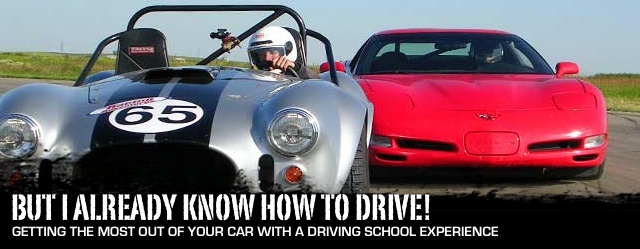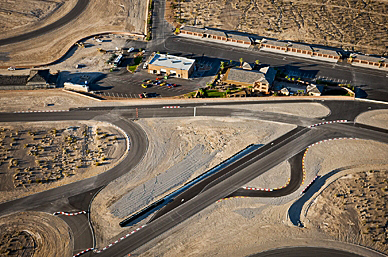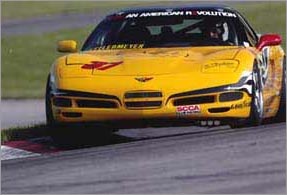Quick! You’re just cruising along in your car when a chunk of re-tread comes flying at you in a fast curve. What do you do? Are you going too fast to turn in to the curve tighter, risking a spin? Can you dip off the road a bit on the right shoulder? You have milliseconds to decide, one chance to do it, and the wrong decision will put you in the weeds, or even the hospital.
That’s the kind of panic you will avoid when you learn to actually drive your car to the limit. With some instruction, you would have known to enter corners with a good idea of what your car’s safe speed is (most drivers have no clue). You’ll know instantly if your car is on the edge or whether it can be pushed a little harder to tuck inside. And because you’ve taught yourself to observe conditions before they happen, you know going in if the shoulder is available for a maneuver. You may have even backed off a bit, noticing several car-lengths back that the tire on the truck ahead of you was about to let go!

Racing schools can run the gamut from austere to opulent. GM chose the country-club-like Spring Mountain Ranch facility in Nevada to introduce their Z06X and SSX concept cars to the press.
Everyone Thinks They’re Above Average
You say “But I already know how to drive.” Though you may know how to get from point A to point B, if you haven’t had any performance driving education, then all you have really been trained to do is avoid tickets. You do not know how to drive. Avoiding tickets, like when to stop and when to yield, is all that most drivers are ever taught.
“But I’ve been driving for years!” Then you know how to get around. So long as the roadways remain clean and dry, no other driver around you does something stupid, and you have no emergencies, you may do just fine. But unless you have had the opportunity to safely recover from a spin, to feel the right time to let off the brake pedal as the wheels skid, or to keep yourself from over-correcting a slide, then there is no way to know if you’ll do the right thing when you have but a millisecond to decide.
The single greatest potential cause of you being in a wreck is your own error.
So it is logical to assume that “Driver Error” is a primary cause of car wrecks as well. If you discount the fact that most plane crashes involve one plane, whereas most car collisions involve at least one other driver, who arguably could be the one at fault, you still end up with a conclusion that the highest significant cause of car wrecks is driver error, considering the vast difference in training between pilots and drivers.

A driving school will give you the chance to experience your car's full capabilities, pushing to the edge and beyond, without the unpleasant consequences of doing it on the street.
To put this in another way, the single greatest potential cause of you being in a wreck is your own error, or not being able to avoid someone else’s mistake. But there is a great way to fix that – Performance driving schools! They’re a lot more fun than you ever thought. It’s like getting an E-Ticket ride to make you a safer driver.
Not only do they make you safer, they make you smoother (your passengers will appreciate that) and you will learn and adopt subtle techniques that will make your car last longer, especially the mechanical bits like brakes and clutch. Even if you don’t figure in the intangible benefit of not killing yourself or somebody else and just look at it in terms of increased performance per dollar spent, a professional driving school is downright cheap! And keep in mind – becoming a better driver is one modification that you take with you no matter what car you drive.
Theory and Practice
So what is a driver’s school? Most of them have a similar format: the day starts with a classroom setting, where you learn the basics. Diagrams of the track show you how they want you to go through a corner. Safety protocols are explained, and you may start by riding with one of their professional drivers. Or they may start by riding with you to evaluate your abilities.
After a number of laps, explaining why the car did this or that, you may take a break to de-brief, and then more laps. Throughout the time, you will take more and more laps, in each session probably given some new focus to achieve, like smooth transitions or trickier things like threshold braking.
You may have a session on a skid pad or a wet-pad, or both. These seem boring by description, but they’re actually one of the most instructive parts of driving schools. Until you have experienced what it feels like for a car to lose its grip, there really is just no way to learn it. Learning it on a controlled skid pad is so much better than on a freeway off-ramp.
To illustrate this is not really about speed, you will find yourself looking at your track times and, rather than comparing that to other drivers’, you will be comparing your own consistency. While anyone can put together one good lap (and a bunch of mediocre ones), a sign of progress is being able to run times that are consistent lap-to-lap.
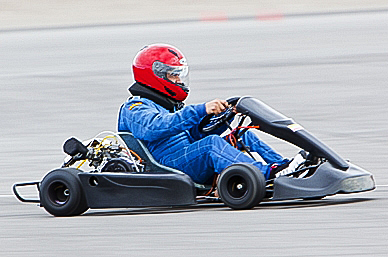
Driving schools aren't just about flogging your own car - you can also book "arrive and drive" classes in everything from shifter karts to Fomula cars, as well as a variety of high performance street cars.
Another thing you will learn is when the track “Resident Hot-Shoe” takes your car and does the same lap at 1:05 when you’ve been turning 1:15. Wait – you drive this car every day, and you smoke those pesky Porsches at every light. And you were hammering the gas and nailing the brakes at this track… how could this be?
Smoothness. And track-familiarity. He knows where to add gas so it does not upset the balance. He knows how to carry the inertia through corners. These are things you too will learn to do at the school, and then you will find yourself practicing them on your favorite twisty roadway, daily. Again, it is not about speed. You can practice these techniques, and others, well within the speed limit, and your car will provide new dimensions of enjoyment. You will come to appreciate what all the fuss is about in the “performance” part of high-performance, without raising your insurance rates with a claim.
No Substitute for Situational Awareness
Many of the schools emphasize visual awareness. Undoubtedly you’ve noticed how few other drivers even have their rear-view mirrors aimed correctly. They can’t see what’s around them, and they don’t even know it! Driver schools teach you that kind of thing and much more, like learning to watch the eyeballs of other drivers. Do they see you? Where are they looking? It only takes a little bit of time on-track where everyone is focused on the task of driving to realize how much of an allowance you have to give on the street for other drivers more interested in texting or their cup of coffee than controlling their cars.
Your car is a sharp-edged scalpel, but you’re only using it to slice butter.
Still not convinced? Think of it another way. You and most every driver around, learned and spent the vast majority of their time in, a car with an “adequate” power-to-weight ratio. A car with brakes designed for one or at most two, high-speed stops in a row. Most every driver has no idea what pressure they have in their tires, nor even what pressure they’re supposed to have. Look at the tires of most cars in a parking lot. Most have bad wear patterns – they’re out of alignment. Or no tread. That’s the “other guy.” And here you are in a car, with brakes that can stop it on a dime, capable of 1g lateral acceleration, and a power-to-weight ratio that rivals Italian supercars. Even if you fully know how to handle your car, think of this picture: you’re flying an F-16 into a crowded airport with no Air Traffic Controller, in airspace full of Cessna’s and blimps, and their pilots are texting each other. A little bit of extra training on your part is not too much to ask.
Taking the Next Step
Presented here, in no particular order, are some of the country’s top driving schools. It’s worth the time and effort to do a little bit of your own research to determine what best suits your needs – an arrive-and-drive package on the far side of the country might be a better fit for your educational goals than a school within driving distance where you can run your own car, so keep that factor in mind when choosing how to improve your skills.
 Spring Mountain Motorsports Ranch
Spring Mountain Motorsports Ranch
Pahrump, Nevada
888-856-5870
Located a little more than an hour’s drive north of Las Vegas, Spring Mountain Motorsports Ranch takes the “country club” approach to their facility, with plenty of amenities besides lots of asphalt and cars.
They also boast a specific course for Corvettes, the Ron Fellows School, and a “real” race car school using the Radical PR6, track-ready light-weight race cars that look like open-top American LeMans spec-racers with six speed sequential gearboxes, fully adjustable suspensions, and aerodynamically-optimized bodywork, FIA-sanctioned safety components… and 500 horsepower! Their Corvette school includes ZR1, Z06 and Grand Sport models in the fleet.
 Bob Bondurant School of High Performance Driving
Bob Bondurant School of High Performance Driving
Chandler, Arizona
800-842-7223
Bondurant offers instruction from as little as $75 per person, all the way up to complete packages for $5,800, all on their own custom-built track in Arizona , plus three at Firebird Raceway. They also offer executive protection and military-spec counter-terrorist driver training. Shifter karts and racing programs are also available. If you’ve never heard of shifter karts, these are not the solid-axle platforms with lawnmower engines you may remember seeing at the local hardware store. Shifters hit over 100 MPH and are the preferred method of training by the upper levels of professional drivers world-wide.

The Bondurant school offers shifter kart instruction, which is about the most "bang for the buck" possible in wheel to wheel racing.
Their fleet includes the Corvette Z51, Z06, Cadillac CTS and CTS-V, the Pontiac Solstice, and Police Package Chevrolet Tahoes and Impalas. Bondurant’s own race series uses 1,100-pound 180-horsepower open-wheel formula cars.
They conduct several different schools, including one attended by 90% of the NASCAR drivers to learn road-racing skills (heel-and-toe shifting, corner entry, etc.), Advanced Road Racing, SCCA-accredited training, their Grand Prix Roadracing School, a High-Performance Driving School with 2011 Camara SS training cars, and an Advanced Teen Driving School.
They also have special skid cars with outriggers that let instructors press a button to make the car “cut loose” sideways, illustrating weight-transfer principles. It is so important that, “This is part of all of our classes,” says the Bondurant School’s John Prumatico. He points out that, “just our advanced skid-pad practice could save your life.”
Prumatico is justifiably especially proud of their specific Corvette instruction. “Our Z06 Experience is a one or two-day school, similar to our High-Performance Driving school, but specifically designed to show owners what their 505 horsepower car will do on a track.” They also offer a ZR1 school for two days that is included as part of the sales price with the purchase of every new ZR1.
Another plus to Bondurant is its 3-to-1 student-to-instructor ratio. They offer more actual track time than most schools, no speed limits, “and our locations are available throughout the entire year” since they have their own track and don’t have to shut down for the winter months.
 Racing Adventures
Racing Adventures
Scottsdale, Arizona
888-572-7223
This is also the home of the American Performance Driving Club. It is hosted at the Grandsport Speedway, which is, not coincidentally, the very track used by GM to tune the Corvette Grand Sports back in the 1960s.
They conduct schools at five tracks: Grandsport (Houston, Texas), Mosport (Toronto , Canada), Summit Point (Washington, DC), Willow Springs (Southern California), and Arizona Motorsports Park (Phoenix). Their prices range from $400 to $600 to start, with several levels of instruction. They also offer vintage Cobra spec racers, and soon the Lotus Elise and Ford GT40 replicar. Those programs cost about $3,500.
Their courses include “vision exercises” to increase perception, knowing that “99% of good driving is vision more than fitness,” according to David Zubick there. He notes that driving your Vette at one of their schools can also make the driver safer because you no longer feel the need to go faster on the street. Once you’ve done 150 MPH at one of their schools, driving 80 on the street is not as much of an irresistible need. Too many drivers simply do not understand that they do not have the experience to handle such a high-performance car. Zubick says, “Everything you learn in our schools you will use on the street.”
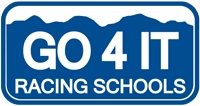 Go 4 It Racing Schools
Go 4 It Racing Schools
Pueblo, Colorado
303-666-4113
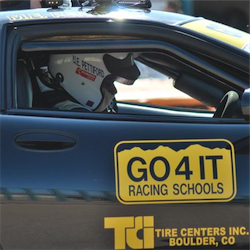 Go4It, which uses Pueblo Motorsports Park in Pueblo, Colorado , offers both three and six-day courses, ranging from $500 to $800 per day.
Go4It, which uses Pueblo Motorsports Park in Pueblo, Colorado , offers both three and six-day courses, ranging from $500 to $800 per day.
They also offer motorcycle, truck and trailer-driving instruction (useful for those who would like to learn how to get their dedicated racecar to and from the track safely) as well.
They use several different Corvettes, the Pontiac Solstice GXP and SSB, Proteges, Mazda MX6s, and street bikes in their curriculum.
 Skip Barber Racing School
Skip Barber Racing School
Lakeville, Connecticut
800-221-1131
Operating since 1975, now with over 200 staff, 150 race cars, and fleets of support vehicles, Barber can lay claim to being the largest driving school in the world. They have corporate programs, and they also sponsor championships; if you end up really liking the school and want to do more, they have plenty of depth to challenge you.
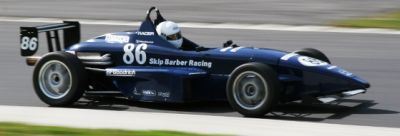
The Skip Barber schools also offer open-wheel Formula car racing instruction for those looking for a different experience than their street car offers.
Prices range from $800 to $4,400 for multi-day racing schools. And they use four different tracks: Lime Rock (Connecticut), Road Atlanta (Georgia), Laguna Seca (California), Sebring (Florida), Watkins Glen (New York), Mid-Ohio (Ohio) and Road America (Wisconsin).
Cars available at Skip Barber include Formula Mazdas (open-wheel race cars, like a small Indy car), Mazda 3 and MX-5 Cup (and the street version), the RX-8, BMW-M3, Lexus IS-F, Lotus Elise SE, Exige S240, Porsche 911, Cayman and Boxster.
![]() Sports Car Driving Experience
Sports Car Driving Experience
800-453-5506
Held at Roebling Road in Georgia, plus Homestead, Sebring, and Palm Beach in Florida, they offer one and two-day schools with prices that vary from $1,500 to $2,600, based on the location. They limit class size to 14.
 Henry Gilbert at this school emphasizes that they teach the, “car control you need to know for the street,” assisting with accident avoidance and hydroplaning exercises.
Henry Gilbert at this school emphasizes that they teach the, “car control you need to know for the street,” assisting with accident avoidance and hydroplaning exercises.
Skills and Thrills
Which driving school is right for you depends on a lot of different factors. While it’s easy to get caught up in the details of the location, the track layout, and what cars you’ll be driving (the school’s or your own), the most critical component in getting the most out of the experience is the instructors. Decide beforehand what kind of training you want. Are you looking to make the step into organized competition? Have you wondered what the true limits of your car are, and want to discover them in an environment where “stepping over the edge” isn’t an expensive and possibly fatal mistake? Or do you just want to go fast, have fun, and become a better driver?
Whatever you’re looking for, a little bit of research, both by contacting these schools yourself and soliciting the advice of online forum members and your fellow enthusiasts, will go a long way to finding the right place to improve the most crucial component of your car – the driver.



